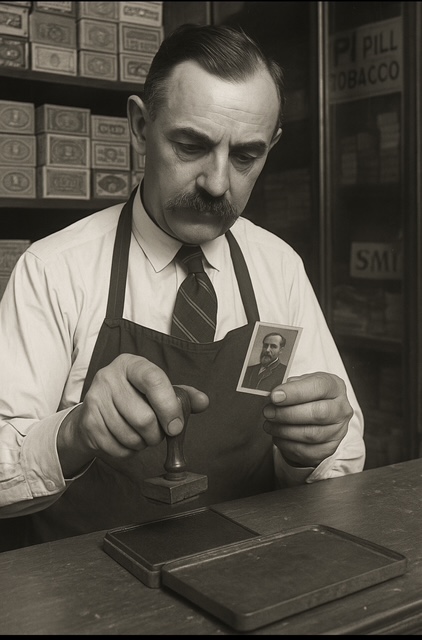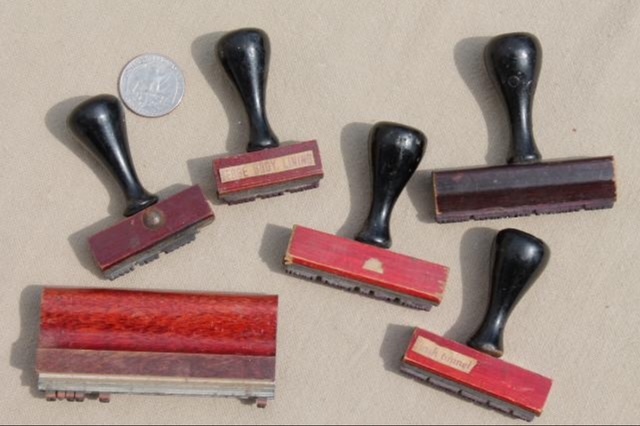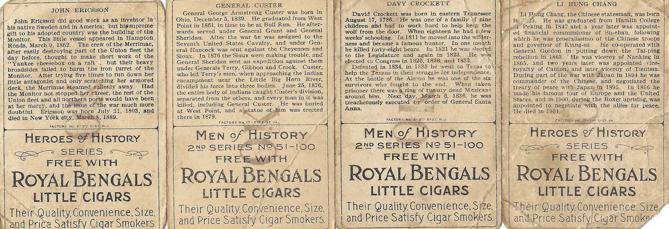
By DB Sikes
A Fictional Scene, Rooted in Historical Truth
Newark, New Jersey — Spring, 1911
The bell over the loading dock rang twice before Mr. Keane barked his orders from the catwalk.
“Douglas, mark the Royal Bengals for westbound shipping. Don’t smear the ink.”
“Yes, sir,” I called back, already dabbing the Carter’s violet onto the worn rubber stamp. The crate was fresh—ten boxes of cigars packed tight, each one with a miniature marvel tucked inside: a Men of History tobacco card. Davy Crockett, General Custer, Captain John Ericsson, Li Hung Chang—names that sparked admiration or debate at barbershops and hotel lobbies across the country.
I thumbed the back of the first card and pressed the rubber stamp just above the factory line: OK. Nothing fancy. Just a clerk’s nod, a quiet signal that this box had been checked and cleared.
Most men wouldn’t even notice the stamp. But I did. Because even a tiny mark can tell a story.
The “OK” Stamp: Mystery, Ink, and Inventory in the Tobacco Era
The rubber “OK” stamp—circled or plain—remains one of the most overlooked yet historically rich quirks in early 20th-century card collecting. For today’s collectors of the T68 “Heroes of History” set, the occasional discovery of this faded violet mark on a card’s reverse side opens a window into the unglamorous but fascinating world of tobacco card distribution.

What Was the “OK” Stamp?
Unlike the factory-printed brand backs (Royal Bengals, Miners Extra, Pan Handle Scrap), the “OK” stamp was not part of official production. Instead, it was a rubber stamp impression—often circled and faded—that read simply “OK.” It was applied post-production, typically at distribution hubs, during inventory checks, or in retail environments.
Ink and Impressions
The ink was almost always violet or gray-blue, consistent with early stamp pads. Over the decades, these oil-based inks oxidized, leaving soft brown or purple remnants. The cards themselves, uncoated and porous, allowed the ink to absorb and feather slightly—making each stamp unique.
Collector Perspective
To a condition-focused collector, any writing or stamping can be a flaw. Grading companies like PSA or SGC will note it as “MK” (marked), potentially lowering the numeric grade. But to historians and master set builders, these stamps are something else: A human fingerprint in the industrial process. A whisper of the working class behind the glossy finish of a gilded age.
A Mark Worth Keeping
For those building a T68 master set, the “OK” stamp represents more than a curiosity—it’s a layered piece of history. While not part of the official print run, it reflects the real-world journey of a card: from print shop to cigar box to warehouse to counter.
It reminds us that in 1911, a stamp wasn’t a mistake—it was a job. A man at a desk with an ink pad and a quota. And the result? A stamp on a card that, over a century later, still says something simple but powerful: OK. Accounted for. Still here.

Want to Help Document More?
If you’ve encountered T68 cards (or other tobacco-era cards) with similar “OK” or inspection markings, I’d love to hear from you. Send clear images, back brand info, and factory numbers to:
Let’s preserve the hidden story stamped in violet ink—one card at a time.
Leave a Reply